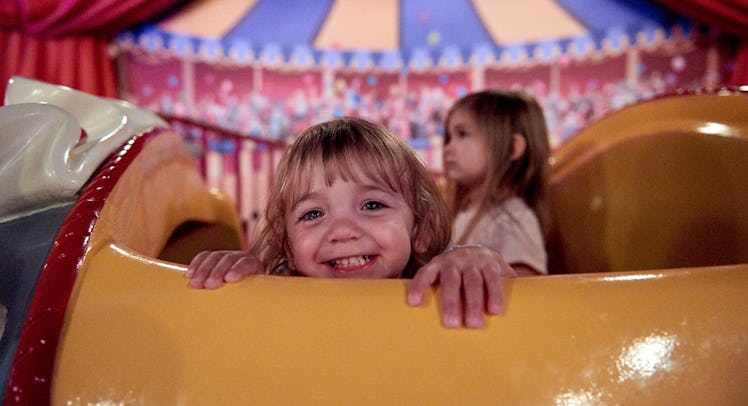What Happens To a Kid’s Brain When They’re Awestruck
Parents live for those magic moments, when kids' eyes get big, jaws drop, and a smile beams. There's a science to it all.

The following was produced in partnership with our friends at Walt Disney World Resort, who invite you to discover a world of magic and memories the whole family will share.
At age 5, my parents took me to the city to see the The Nutcracker. Sitting in my seat, I craned my neck to watch the dazzling figures in bright costumes twirl to the sounds of Tchaikovsky. Then suddenly, something amazing happened. The Christmas tree on stage began to grow. And grow. And grow. It grew until it was super-human size, touching the ceiling of the cavernous theater. My jaw dropped and my eyes grew wide. I was in awe.
Many years later and well into adulthood, I still remember the amazement I felt as a child. Of course, I now understand that the tree was being raised mechanically, and it was made of plastic, not pine needles. But that sense of wonder has stayed with me.
What Is Awe?
It turns out, the awe I was feeling is part of a relatively new and rapidly growing area of psychological research. In a foundational paper on the topic in 2003, researchers at the University of California Berkeley described the emotion of awe as “in the upper reaches of pleasure and on the boundary of fear.” It combines a perceived vastness of something with an attempt to understand it on a personal level. Other awe-inspiring experiences might include: Seeing shooting stars; witnessing an acrobat walk a circus tightrope; getting onto a bright, big amusement park ride; meeting a TV character “in real life”; encountering a whale on a deep-sea dive. These are moments that stretch the imagination and leave us with a sense of pure joy — the kind of moments that stick in our memories of childhood, that strongly feel like part of who we are.
An awe-filled moment at Epcot®. (Photo by Daniel DeWaard)
Why Kids Are Awe Magnets
Given that awe is often produced in response to new experiences, it’s no wonder that the emotion is one kids encounter with some frequency. The rising Christmas tree was one of the more lasting memories, but in reality, my childhood was one long string of awe-filled moments. “Something that might feel mundane to you could feel astonishing to a young child seeing it for the first time,” says child development expert Amber Ankowski, Ph.D., and co-author (with her husband Andy Ankowski) of Think Like a Baby. “From seemingly small activities like planting a garden together to more obviously impressive experiences like a family trip to the Grand Canyon, awe can come in all shapes and sizes.”
It’s also an emotion inextricably linked to imagination and creativity — one study in The Journal of Experimental Child Psychology found that children exposed to expansive images were better at creative problem solving than those who viewed narrower, more pedantic ones.
The Awe Connection
Awe makes kids potentially better problem solvers, but there’s also studied physical benefits that make seeking out those awe-filled moments all the more worthwhile. A study in the journal Emotion found that an experience that includes awe can measurably lower physiological symptoms of stress and increase a sense of social connectivity. What’s more, the study found those perks remained up to two weeks after an awe-inspiring outdoor adventure — meaning the effects of awe are relatively long-lasting.
Taken further, awe can also act as a protector against illness: In a study by University of Toronto psychologist Jennifer Stellar, Ph.D., researchers found that increased levels of awe correlated with a decrease in the body’s level of pro-inflammatory cytokines, biomarkers for a host of negative health issues. “We’re not exactly sure why,” says Stellar, “but it’s possible that awe lowers stress levels, which in turn could reduce these biomarkers.” (Stellar points out that other studies show negative emotions increase cytokines in the body, so it’s logical that positive emotions like awe may have the reverse effect.)
An awe-inspiring scene from Disney’s Magic Kingdom®. (Photo by Jason Roth)
How Awe Teaches Kids Life Skills
Other research suggests awe improves altruistic behavior, increases a sense of humbleness, leads to greater life satisfaction, and is linked with curiosity. That’s especially important for young kids, since curiosity encourages learning. For me, that enchanted December evening watching snowflakes twirl and sugar plums waltz turned into a childhood passion for dance and music. Twelve years of ballet turned into four years of modern dance in college, followed by two internships with top dance companies in New York City. And while my career path changed over time, dance taught me lifelong lessons about the discipline required to train hard, the ability to push physical limits, and the pure joy of expressing emotion through movement — lessons that began so many years ago watching a Christmas tree grow.
Feature photo by Greg Brouillette.